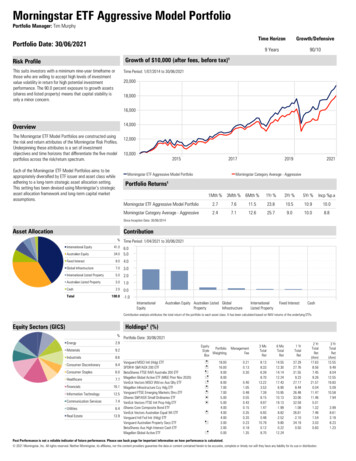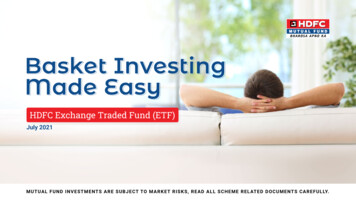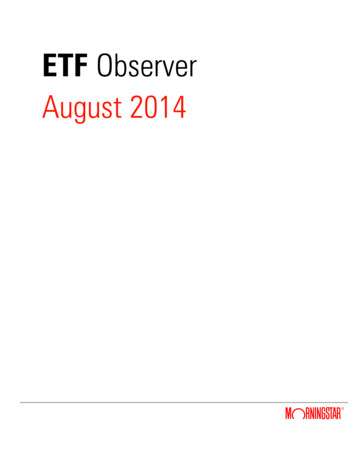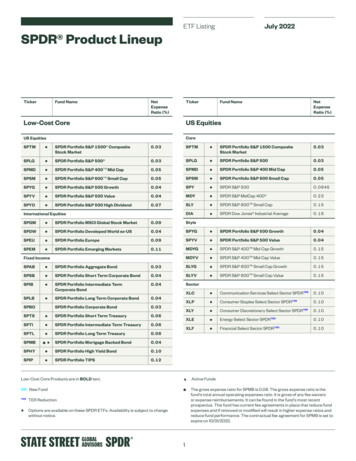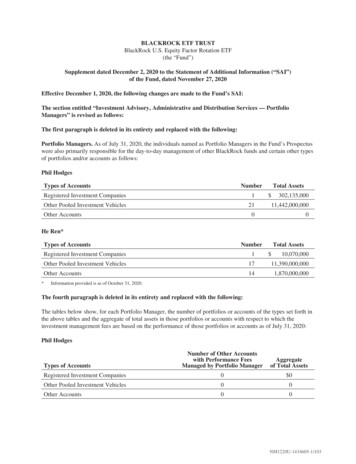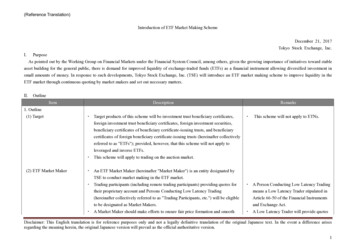
Transcription
The ETF (Exchange Traded Fund) market is growing at a rapid pace. ETFs areno longer considered a niche product and a growing number of organisationsare likely to enter this market in the future. To help asset managers prepare tocompete in this fast changing environment, we have considered the ongoingevolution, barriers to growth and the opportunities that lie ahead, and howthey can plan for 2020.ETF 2020Preparing for a new horizonwww.pwc.com/ETF2020
2 PwC ETF 2020
3 PwC ETF 2020ContentsExecutive SummaryOngoing evolutionImpediments to growthOpportunities ahead4556ETFs in 20208Growing global footprintMore segments adoptProducts proliferateService providers evolveOptimistic economic outlookThe power of policy8911121314Regional SummariesEuropeAsiaUnited States161819Challenges on the horizonRegulatory and tax issuesThe distribution problemIncreasingly crowded marketsNew entrantsNeed for investor educationInnovation cuts both waysTechnological disruptionThe Strategic ImperativeA shifting competitive environmentSuccessfully planning for 2020Seizing the momentContacts20212121212222222424252728
4 PwC ETF 2020ExecutivesummarySince their introduction only two decades ago, ExchangeTraded Funds (ETFs) have been undeniably successful.Growing far beyond their initial function of tracking largeliquid indices in developed markets, ETFs now hold over 2.6trillion of assets globally.1 ETFs are listed on an ever growingnumber of exchanges and are being used by investors in agrowing number of markets. New investor segments continueto integrate ETFs into their portfolios and fund sponsorscontinue to introduce new products.The proliferation of ETFs was identified in our AM 2020 publication as one ofthe six game changers in the asset management (AM) industry. ETFs are nolonger a niche product, and their impact will continue to be felt much morewidely than imagined. As such, all financial services firms should considerdeveloping an ETF strategy. This may be an obvious choice for firms planningto manage, service, or distribute ETFs, but it is also important for firms thatwill be competing in an environment that is increasingly shaped by ETFs.In 2013, PwC explored the rise of ETFs in depth in ‘The next generationof ETFs’. Based on the history of ETFs and a close examination of recentdevelopments, this paper identified key trends, highlighted potentialobstacles to growth and articulated how industry players might formulatecoherent strategies to deal with ETFs. Since then, we have gone on to surveyasset managers, service providers and other industry participants aroundthe world in an effort to better understand regional developments in ETFsand use their expertise as a sounding board for our own perspectives.This report leverages the results of our global survey and our insights topaint a picture of how the ETF business is likely to evolve globally over thenext six years.About the surveyPwC surveyed executives from approximately 60 firms around theworld in 2014 using a combination of structured questionnaires andin-depth interviews. Two-thirds of the participants were ETF managersor sponsors, with the remaining participants divided between assetmanagers not currently offering ETFs and service providers. Participatingfirms account for more than 70% of global ETF assets.1 BlackRock, ‘ETP Landscape: Industry Highlights’, 30 June 2014
5 PwC ETF 2020Ongoing evolutionWe begin by looking at the growingglobal footprint of ETFs. The U.S.market has led the way to date,but other markets demonstratesignificant growth potential. Theseopportunities are accompaniedby regional differences in marketdynamics, investor preferences andregulations, so global aspirationswill need to be supplemented withadditional regional resources andexpertise.We next examine the increasinglycomplicated segmentation ofthe ETF market. Institutionaluse continues to drive assets asa growing variety of firms finduses for ETFs. The advisor marketcontinues to evolve quickly, withETF strategists playing a growingrole in the U.S. market and nowemerging in Europe. Segment andchannel trends are largely drivenby local considerations, so regionaldifferences abound.The flood of new ETFs has slowedin some regions (i.e. the U.S.) andproliferated in other regions (e.g.Europe and Asia) since the financialcrisis in 2008. Non-traditionalindexing is an important trend inmost markets, while active ETFs areon the verge of radically changingthe AM industry in the U.S.Operational service providersare likely to play an increasinglyimportant role in ETF markets as feepressures mount and an ever morecompetitive environment cause fundmanagers to look for effective andefficient means of bringing productsto market. Such firms could alsoserve as catalysts for further growthby offering turnkey platforms thatminimize the barriers to entry facingprospective new market entrants,particularly smaller, less establishedfirms and those looking to gainaccess to geographies beyond theircurrent footprint.Fee pressure may be mounting,but ETF sponsors remain relativelyoptimistic about their financialpicture, with more than half of thosein the survey predicting increasedprofitability and only one in fiveexpecting a decline in profits. Assetgrowth will most likely continue toboost top-line revenue, but a varietyof factors may conspire to pressurethe bottom line going forward.Regulations have the power toencourage as well as limit growth.Most near-term rule changesare seen as likely to improve theregulatory environment for ETFs,but there is still much that could bedone, particularly in markets likeJapan where distribution efforts arehobbled by the continued practice ofsales’ commissions on mutual fundsales.On 21 October 2014, the Securitiesand Exchange Commission (SEC)denied requests for exemptive relieffor two firms seeking approval tolaunch non-transparent active ETFs,which would provide less than thecurrent daily transparency of theportfolio holdings using a blindtrust. In early November 2014,the SEC approved the request foranother firm to launch a differenttype of non-transparent activeinvestment product referred toexchange-traded managed funds.This development has generateda lot of interest by current andprospective ETF sponsors. Weexpect that firms will continue toseek regulatory approval to launchnon-transparent active ETFs,which could provide another phaseof growth and innovation in thecoming years.Impediments togrowthThe popularity of ETFs is unlikely toabate, but there will be challengesin the coming years. Among theseare changing demographics,which will have asset managersincreasingly tasked with designing
6 PwC ETF 2020As more typesof investmentstrategies becomeoperationallyfeasible and arepermitted byregulators, agrowing numberof firms are likelyto enter the ETFmarket.solutions suitable for a rapidlyageing population. Technologycould also challenge ETF firms,with its power to radically alterthe way investment advice andproducts are evaluated andconsumed. Regulatory constraintsand distribution dynamics favouringother types of investments mayslow growth in some markets. Afurther complication in the U.S. is anincreasingly saturated marketplace,crowded with firms eager to sharesome of the assets flowing into thisfast-growing corner of the industry.Opportunities aheadDespite myriad challenges,opportunities abound for existingETF firms as well as others willing todevelop a thoughtful and informedstrategy as they prepare to addressthis market.As more types of investmentstrategies become operationallyfeasible and are permitted byregulators, a growing numberof firms are likely to enter theETF market. As the marketbecomes more crowded, productdifferentiation will becomeincreasingly critical (and difficult).Brand building is important, butdoing it effectively may hingemore on educating investors withthought leadership than traditionaladvertising.Shifts in the regulatory environmentwill produce opportunities thatmay favour firms with local marketknowledge.The ability to transform ETFs intoeffective solutions that address theneeds of specific investor segmentsmay be a particularly importantfactor in competing successfully.Deep expertise, differentiatedproducts, brand awareness, investoreducation, regulatory savvy and theability to craft innovative solutionsare all pointless without effectivedistribution.The ETF market is a fast-growingbusiness with many appealingqualities. It is also undergoingsome transformative changes thatwill make it much bigger and morecompetitive within a few years.There is no single approach thatis likely to work for firms lookingto take part in this business. Eachfirm will have to evaluate theconsiderations outlined in thispaper and formulate their plan,based on their own capabilities andobjectives.We are grateful to everyone whocontributed to this paper and tothose who participated in our globalsurvey. It is our sincere hope thatit proves useful as you put togetheryour ETF strategy.
7 PwC ETF 2020
8 PwC ETF 2020ETFs in 2020Despite lukewarm economic growth in much of the world,the AM industry remains a vibrant growth business. Havingdoubled over the past decade to approximately 70 trillion,we project professionally managed financial investments togrow at 6% per annum to approximately 100 trillion by2020.2 Some of this growth is expected to come from marketappreciation, but strong new asset flows are also likely tocontribute significantly.ETFs will play an increasingly prominent role in this growth, accountingfor an increasing proportion of asset flows in many markets and investorsegments. ETFs now hold approximately 2.6 trillion of assets globally.3Their rapid rise can largely be attributed to the growing acceptance ofindexing, but ETFs are likely to get an additional boost in the coming yearsfrom greater penetration of global markets, growing acceptance amongmore types of investors and the introduction of a wider variety of investmentstrategies. ETFs are widely expected to continue growing. More than threeout of four survey participants said they expect ETF assets to at least double,reaching 5 trillion or more by 2020. Others are not so sure, predictingmore modest growth rates or a gradual slowdown as market penetrationreaches its limit.Growing global footprintWith more than 5,400 products listed on 60 exchanges by 222 fundsponsors, ETFs are already a global phenomenon.4 Assets are still heavilyconcentrated in certain markets, but globalisation will continue as ETFsproliferate and address a growing number of niche asset classes, a scenariothat has played out in more mature markets and is likely to be repeated innewer markets as well.In absolute terms, asset flows in the developed markets of the U.S. andEurope will dominate the global ETF landscape, but the highest rates ofgrowth are likely to be found in less mature markets. Asian investors havehad access to ETFs for some time, but are only now adopting them ingreater numbers. Currently accounting for 7% of global ETF assets,5 thesheer number of investors in the region combined with economic growth,rapid wealth creation and a quickly evolving financial services landscapemean that Asia is likely to contribute significantly to the growth of ETFsin the coming years.6 Capital flows will accelerate further with the likelyinternationalisation of the Chinese renminbi, which will open up what willbecome one of the world’s most important AM markets.
9 PwC ETF 2020Investors in Latin America, theMiddle East and Africa have beenintroduced to ETFs even morerecently. The fact that they currentlyaccount for only 2% of global ETFassets only serves to illustratethe potential for growth in thesemarkets as investors familiarisethemselves with the benefits ofETFs.7There is no consensus on whetherthe North American and EuropeanETF markets are mature. It is quitepossible that growth in thesemarkets will slow, but it is notunreasonable to think that certaindevelopments could reinvigoratedemand and actually cause assetgrowth to accelerate in thesemarkets. Even if Asia becomes thelinchpin for growth in ETF assets,sufficient demand there could easilycause assets to climb past the 5trillion mark by 2020.More segments adoptETFs appeal to a diverse arrayof investors and intermediaries.Everyone from financial plannersto hedge fund managers, insuranceexecutives and central bankers canfind something to like about ETFs.A survey participant pointed outthat ETFs give institutional andretail investors the ability to expressand execute investment views in anefficient, low-cost and transparentway – something that was notpreviously available in the localmarket.2 PwC, ‘Asset Management 2020: A BraveNew World’, 20133 BlackRock, ‘ETP Landscape: IndustryHighlights’, 30 June 20144 ETFGI, ‘ETFGI Monthly Newsletter,July 2014’, 7 August 20145 BlackRock, ‘ETP Landscape: IndustryHighlights’, 30 June 20146 BlackRock, ‘ETP Landscape: IndustryHighlights’, 30 June 20147 See footnote 6 above8 PwC, ‘The Next Generation of ETFs’, 2013As ETFs become more global, theywill find their way into the portfoliosof a wider array of investors. Havingled the way in most markets,advisors to individual investorswill continue to drive demand forETFs. The ease of use, low cost andliquidity of ETFs has made thema favourite among advisors, whoin many cases are taking on moreof a portfolio management role asthe emphasis shifts from securityselection to asset allocation. Thegrowing ranks of affluent investorsin Asia and elsewhere mean demandfrom advisors will almost certainlyexpand.It is institutional investors, however,that are widely expected to be theprimary growth driver in comingyears. Insurance companies, pensionplans and hedge funds in particularare projected to be significantsources of demand for ETFs.Insurers are increasingly lookingto ETFs as sub-account options forincreasingly sophisticated tacticalstrategies.8 Defined benefit planshave already started using ETFsin greater numbers, and definedcontribution plans may well followwith the introduction of moretarget date and target risk ETFs.Having long used ETFs in a varietyof strategic and tactical roles, hedgefunds are unlikely to turn awayfrom an investment vehicle thathas proven so useful in the past.Wealth management platforms,central banks, foundations andendowments are also expected touse ETFs in greater numbers.“ETFs give institutionaland retail investors theability to express andexecute investment views inan efficient, low-cost andtransparent way – somethingthat was not previouslyavailable ”Segment and channel dynamics canvary from one region to another,and differences can sometimes bestriking. The benefits inherent inthe ETF as an investment vehicle arealmost universally seen as the keydrivers of their growth to date. Butdemand has come from differenttypes of investors, depending on themarket. In the U.S., retail demandis more likely to have been seen asa significant growth driver to date.Outside of the U.S., institutional
10 PwC ETF 2020investors are more likely to becredited with having driven assetgrowth in a meaningful way(Figure 1).Figure 1: Significant growth drivers to date (more than one responseprovided)% of linvestorsRetailinvestorsInvestoreducationn U.S. n Non-U.S.Source: PwC Global ETF Survey, September 2014There is noconsensus onthe retirementmarket. Some fundsponsors see it as amajor opportunity,while othersdismiss it as a deadend where ETFscannot competeeffectively.Looking forward, financialadvisors, retail investors and wealthmanagement platforms are expectedto be the top three segmentsdriving demand in the U.S. market.While the retail business is notinconsequential outside of theU.S., demand will most likely comefrom different sources. Insurancecompanies, retirement plans andhedge funds are expected by Asianfirms in the survey to be the biggestsources of demand in the next fewyears. Meanwhile, private banks andwealth management platforms arewidely seen by European firms as asignificant source of future demandfor ETFs (Figure 2).ETF sponsors are considering everyavenue. Sovereign wealth fundsare seen by some as a potentiallymajor source of demand. Others aretargeting local banks and financialinstitutions.There is no consensus on theretirement market. Some fundsponsors see it as a majoropportunity, while others dismissit as a dead end where ETFs cannotcompete effectively.The insurance market is seen bysome as potentially one of thebiggest untapped opportunities forETFs. ETFs have not yet penetratedvery deeply into this massive pool ofassets, but opportunities abound fortheir use, not only as building blocksin packaged products, but also asassets on insurer’s balance sheets.One important area of changein the ongoing evolution ofthe AM business is the role ofintermediaries, who are increasinglyacting in advisory capacitiesrather than simply acting asbrokers. As a part of this shift,these intermediaries are beingcompensated differently, with feeoriented models becoming prevalentin many markets. Asset-based feescreate a powerful incentive to uselower cost investment vehicles inorder to maximise profitability. Thisincentive is made even strongerby the higher turnover associatedwith tactical asset allocation modelsincreasingly used by advisors.The shift towards fee-based modelsis being reinforced by globalregulatory developments, withauthorities in many jurisdictionsaiming to better align the interests ofadvisors with those of their clients.Regulations like the UK RetailDistribution Review (RDR) andMarkets in Financial InstrumentsDirective (MiFID) II in Europe arelikely to lead to interest in cheaperand more cost-effective vehicles.Similar regulations on fee modelsand related disclosures would have acomparable effect on other markets,underscoring the advantages ofETFs and potentially boosting theirshare of retail asset flows.
11 PwC ETF 2020Figure 2: Investor segments projected to generate significant demand (more than one response provided)% of s(retail)WealthplatformsInsurancecompaniesHedge funds/Asset MgrsRetirementplansEndowmentsand foundationsn Significant n Moderate n NegligableSource: PwC Global ETF Survey, September 2014Products proliferateDemand for ETFs is growing asmore investors become familiar withthem. Although new ETFs are notbeing launched at the same pace ofa few years ago, fund managers andsponsors continue to do everythingthey can to meet the needs ofkey investor groups. Rather thandesigning products and hoping theyattract interest, they are meetingwith ETF strategists, investmentadvisors and others to ensure theyunderstand the needs of their coreusers.New types of indexing (also referredto as ‘smart beta’) represent onehotbed of product developmentactivity, with 46% of all surveyparticipants identifying this as themost important area of innovation(Figure 3). Among non-U.S. firms,it ranks first. As they evolve beyondtheir roots, non-traditionallyindexed ETFs are attractingsignificant attention, with a growingnumber of investors opting for indexweightings, based on factors otherFigure 3: Most important area of innovation (more than one g34%Active ETFsNew types of indexingSource: PwC Global ETF Survey, September 2014than market capitalisation, whichcan lead to overly concentratedexposure to certain markets, sectors,or securities. Their vehicle of choiceis an ETF with holdings weighted bycorporate fundamentals (e.g. profitsor dividends), momentum, or someother factor.Central bank
12 PwC ETF 2020There is an ongoing debate overwhether these funds reflect‘active’ or ‘passive’ approaches,but whatever the verdict on thenomenclature, these ETFs aregenerating considerable interest,with growth rates topping thoseof traditional index ETFs and 92billion of assets in the U.S. marketalone by mid-2014.9 Almost half ofthe firms in the survey consider newtypes of indexing to be a key growtharea going forward (Figure 4).Scalability doesn’tappear to be amajor concern.About three infour ETF firms inthe survey claimthat their currentoperationalinfrastructureis sufficientlyscalable. U.S. respondents are particularlykeen on non-traditionalindexing, but they are evenmore enthusiastic about newdevelopments in active ETFs.“It is necessary toconsider the profitmodel and how todeal with lossesbefore productlaunch costs arehigh and ETFs donot necessarilygenerate returns inthe short term.” Alternatives are viewed bysome as an important area forinnovation. A significant number offund sponsors are alreadywaiting in the wings to launchactively managed ETFs. ThisETF executive onproduct strategyFigure 4: Growth opportunities (more than one response provided)Active Non-U.S. firms recognise thelong-term potential of activeETFs, but are quick to point outthe many structural barriersthat need to be dismantledbefore active or alternativeETFs contribute meaningfully togrowth.Service providersevolveWith assets expected to double inthe next five to six years, it is criticalthat the ETF business is supportedby an efficient and scalableoperating infrastructure. Scalabilitydoesn’t appear to be a majorconcern. About three in four ETFfirms in the survey claim that theircurrent operational infrastructure issufficiently scalable. Slightly more than half of the ETFfirms in the survey pronouncedthemselves either satisfied orvery satisfied with quality ofoutsourced services (Figure 5). Some dissatisfaction may stem inpart from a lack of automation,particularly for service providerslocated outside of the U.S., whichis a more mature market.TraditionalindexingAlternativesis particularly true in the U.S.,where the regulatory approval ofnon-transparent active strategiesmay eventually bring a growingnumber of active managers intothe ETF market.New typesof indexingAssetallocation/solutionsn U.S. n Non-U.S.Source: PwC Global ETF Survey, September 20149 Strategic Insight, SimfundMF database, 30 June 2014 High fees are another source ofdissatisfaction, with indexingcompanies most commonly citedas the offending party. SeveralETF firms also say a lack offlexibility on the part of operatingpartners leaves them unsatisfied.
13 PwC ETF 2020 Competition is also puttingpressure on fees. Almost twoout of three service providers inthe survey stated that fees arean issue with which they aregrappling. In many cases, their serviceofferings are integrated andoffered in the form of ‘platforms’.This is business as usual for manyfirms used to the mutual fundindustry, where fund services area mature business.Optimistic economicoutlookETF sponsors are rather morebullish on their financial prospects,with 59% saying they expect theirETF businesses to become moreprofitable this year (Figure 6).Meanwhile, only 14% say profitsare likely to fall in that time. Muchof this optimism has its roots inthe nearly universal belief thatthe market will grow organically,generating additional income. Assetgrowth is likely to be propelled bygrowing demand as well as marketappreciation. Some fee pressure isanticipated, but it is not expected tooverwhelm revenue growth from arapidly growing asset base.Non-traditional index ETFs (socalled smart beta funds) are alreadygenerating significant interest andasset flows, and boosting revenuesfor a growing number of firms.Non-transparent (also known asperiodically disclosed) active ETFsare another example of innovationexpected to directly benefit the topline growth of many asset managers.Figure 5: Level of satisfaction with outsourced operationalservices for ETFs9%12%35%41%Very satisfiedSatisfied3%NeutralUnsatisfiedVery unsatisfiedSource: PwC Global ETF Survey, September 2014Note: ETF managers and sponsors onlyFigure 6: Projected profitability of ETF business in 2014 relative to 201350%% of firms 90% of the service providers saytheir firms have changed theirbusiness model by changingterms or adding resources,streamlining processes,introducing more automation,globalising operations andupgrading technology.26%9%MuchmoreSomewhatmoreAboutthe same12%2%SomewhatlessMuchlessSource: PwC Global ETF Survey, September 2014Improved distribution dynamics arealso seen as a potential source ofstimulus for sponsor revenues. Thisis particularly true in Asian markets,where deregulation and lower crossborder barriers could spur activityand growth.The rise of ETF strategists willcontinue to benefit fund sponsors inthe U.S. market. Already accountingfor more than 100 billion of assets,the 145 strategist firms in theU.S. market continue to introducecomplementary offerings in orderto leverage their distributionnetworks and infrastructure.10 Howquickly the model is applied toother markets remains to be seen,but rapid adoption would benefitmanagers and ETF sponsors.10 Morningstar, ‘ETF Managed Portfolio Landscape’, Q2 2014
14 PwC ETF 2020The impact of traditional marketingand sales’ activities should not bediscounted. Investor educationand brand awareness campaignscould have a meaningful effect onrevenues, particularly in less maturemarkets where ETFs are only nowstarting to find traction among retailinvestors.Growth comes withcosts. Marketingexpenses inparticular areexpected to rise.With competitionheating up invirtually everycorner of themarket, ETFsponsors cannotafford to beoverlooked byinvestors.Meanwhile, deeper penetrationof institutional segments and thebroader secular trend towardsindexing will also continue to benefitthe top line for many ETF sponsors.Growth comes with costs. Marketingexpenses in particular are expectedto rise. With competition heatingup in virtually every corner of themarket, ETF sponsors cannot affordto be overlooked by investors.Gaining and keeping mindshareamong investors and intermediariesmeans increased spending ontraditional marketing campaigns aswell as thought leadership aimed ateducating investors on how best touse ETFs to meet their objectives.Operating costs are also set to rise.Upgrading technology, resources andprocesses will be critical as the ETFlandscape becomes more complicated,with a wider variety of investors and aplethora of new investment strategiesoffered in ETF form.Figure 7: Impact of regulations and tax rules on ETF growth and innovation9%56%35%Significant impactSource: PwC Global ETF Survey, September 2014Moderate impactNegligible impactThe power of policyThe regulatory environmentis widely believed by surveyparticipants worldwide to havemade a meaningful impact on thegrowth and innovation of ETFsto date. Less than one in ten saythe impact has been negligible(Figure 7).Pending regulations are alsoexpected to have a significantimpact on ETFs going forward.New regulations could sparkfurther growth if they permitfurther product innovation or lowerdistribution barriers, but they couldalso dampen demand, particularlyif new tax rules make ETFs lessattractive or convenient.What are some of the key regulatorydevelopments expected to have animpact on the shape and direction ofthe industry’s growth? In early November 2014, theSEC approved a version of nontransparent active investmentproduct called exchange-tradedmanaged funds. There are also anumber of other pending filingsreflecting a variety of proposedapproaches. Will the impact beimmediate? Not likely. But itdoes have the potential to set inmotion a profound rearranging ofprofessionally managed assets. More than three out of four U.S.participants surveyed said theywould expect the regulatoryapproval of non-transparent ETFsto change the ETF landscape inthe future of their firm (Figure 8).In Asia, the three types ofpassporting of funds (see page 18)will necessarily cause regulators towork together to finalise bilateralagreements, be more transparentand clarify rules. The net effectcould be a dismantling of certainregulatory requirements that wereslowing the growth or innovationof ETFs in Asia. The impending‘mutual recognition’ between Hong
15 PwC ETF 2020Kong and mainland China offers anappealing prospect to fund sponsorseager to penetrate the rapidlygrowing market on the mainland,should ETFs be included within itsscope in the future. The successof the Undertakings for CollectiveInvestment in TransferableSecurities (UCITS) framework inEurope illustrates the importance ofthis phenomenon.In Europe, financial transactiontaxes (FTTs) remain an area ofuncertainty. Broad public supportwill likely not be able to overcomefear of adverse economic impact,and failure to agree on commonterms is likely to continue to preventlegislators and policymakersfrom developing the agreementsnecessary for broader enactment.The impact of the proposedEuropean FTT on ETFs will dependon the form in which the FTT isfinally implemented.The distribution landscape is alsobeing reshaped by regulationin Europe and elsewhere. Byeliminating commissions, MiFIDII and the RDR (more in Europe:Regulatory Transformation) areencouraging the use of ETFs. Moreimportantly, they are promotingthe ongoing digitisation of financialadvice. With their specific,liquid, cost-effective exposureto virtually any asset class, ETFsare perfectly suited to new onlineadvice platforms and apps thatare emerging from the shadows oftraditional intermediaries facinggreater regulation.Marketing compliance for ETFs islargely on par with what is requiredfor other investment vehicles, atleast in the U.S. where 58% of ETFfirms in the survey say they arecomparable in cost and complexity.ETF sponsors in other regions do notnecessarily share this perspective(Figure 9).Non-U.S. firms are more likely tosay they expect to see the balanceshift over the next five years, withFigure 8: Effect of the approval of non-transparent active ETFs onyour firm18%23%59%SomewhatNeutralSignificantSource: PwC Global ETF Survey, September 2014Figure 9: Cost and complexity of marketing compliance requirementsfor ETFs vs. other investment vehicles% of firms80%60%40%20
6 PwC ETF 2020 As more types of investment strategies become operationally feasible and are permitted by regulators, a growing number of firms are likely to enter the ETF market. solutions suitable for a rapidly ageing population. Technology could also challenge ETF firms, with its power to radically alter the way investment advice and
